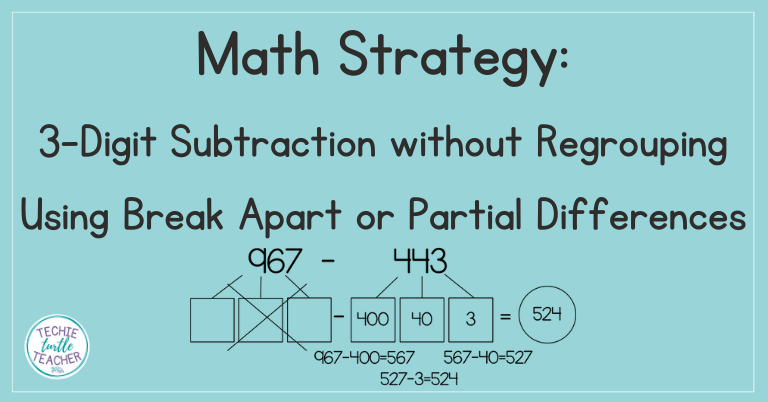Break Apart 3 Digit Subtraction without Regrouping Strategy

Students should be exposed to many different strategies when learning how to subtract 3-digit numbers. The subtraction break apart strategy is helpful for students to visualize numbers broken apart into hundreds, tens and ones. This strategy is sometimes called the partial differences strategy.
This strategy is perfect to introduce after students master subtraction using base ten blocks. Students still need practice visualizing place value, but no longer need to see it as base ten blocks. The standard 2.NBT.7 uses many different strategies to master 3-digit addition and subtraction. I take it very slowly to help with mastery of this standard.
Keep reading to learn more about the break apart or partial differences strategy and to find a resource you can use right in your classroom to teach 3-digit subtraction without regrouping using the break apart strategy.
Break Apart 3 Digit Subtraction without Regrouping Example

What do you think you would do to start solving 967 – 443 using the break apart strategy?
You would break apart the numbers into hundreds, tens and ones just like you would when writing numbers in expanded form.
Important note: When subtracting using the break apart method, it is important to only break apart the second number. (See the example below.) Problems without regrouping still work if you break apart both numbers, but you want your students to get used to only breaking apart one number when subtracting.
In this example, you do not break apart 967, so you cross out those boxes. 443 would be 400, 40 and 3. To help the students visualize, they will write the numbers in boxes below the problem. It’s important to set up the problems for the students from the beginning.
Once the students start to feel comfortable with the strategy, you can have them draw their own boxes to show their thinking.

Be careful with this step! Many students will want to write 4 instead of 400 and 40. This will impact their thinking later on, so be sure to correct that misconception as soon as you notice it.
Once the numbers are broken apart correctly into their place values, students are ready to subtract.
Start with the whole number 967 and subtract the hundreds. Have students show their thinking by writing the number sentences below the boxes.
967 – 400 = 567
Note: Some students will want to keep the numbers in their heads instead of writing on paper. Encourage students to show their work throughout every step. Once they start working with larger numbers or use numbers that regroup, it will be easier to make mistakes if they don’t show their work.

Then subtract the tens from your answer in the previous step. Again, write this number sentence below the boxes.
567 – 40 = 527

Then subtract the ones from your answer in the previous step. Again, write this number sentence below the boxes.
527 – 3 = 524
Write the final answer in the circle. I encourage my students to always write the final answer in the circle so I know they have completed every step.


This strategy is called break apart since you are breaking apart the numbers into their place value to subtract.
It can also be called partial differences because you are getting part of the difference each time you subtract the numbers in different place values.
You can use both names to reference this strategy. In fact, it is important to share this with students so you don’t hear them tell you they don’t know what the strategy means if it is referenced on a standardized test! They do know what to do!
Break Apart 3 Digit Subtraction without Regrouping Practice
Do you need some practice pages for your students to use with this strategy?
Click the image below to purchase the full product on TPT.
Pin this to Pinterest for later






